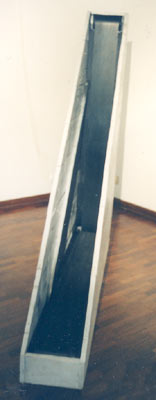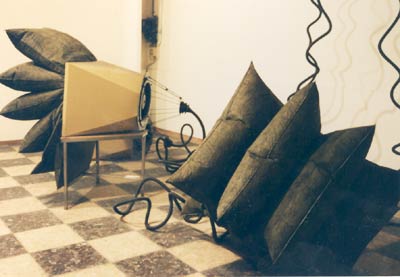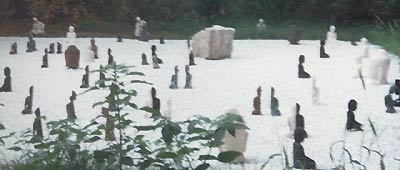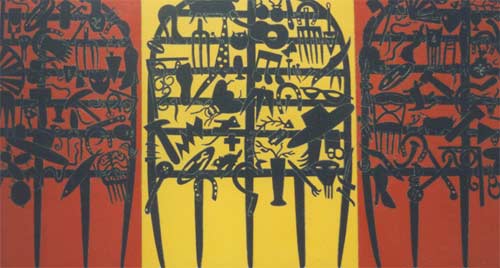| Time-based | Visual Arts | The Netherlands | |||||||||||||||||||||||||||||||||||||||||||||
| Own work | Articles | Letters | |||||||||||||||||||||||||||||||||||||||||||||
BAFA © 2010. All material here is copyrighted. See conditions above. |
Reviewed by Sonja van Kerkhoff The Netherlands.
|

Compressing Space Accelerating Time by Vlastražanić in the Croatian organized exhibition near the city centre. |
Encountering the Venice Biennale?
Printed in the June 1996, Arts Dialogue The 1995 Venice Biennale was more dispersed than the previous one (in 1993). Individual and collective exhibitions were held in a variety of places, and with such diversity that little connection could be discerned. So I was amused when I read four reviews aobut this event referring to it as one entity, with the usual invidious inter-national comparisons. In fact, few could have found most of the locations, and none who had found them could claim that 'this' was the Biennale. |
|
image to come from the Transculture exhibtion... |
|
image to come from the Transculture exhibtion... |
The variety of conversations and his personal observations drew out the particularity of the mementos: inscriptions that exist somewhere between speech and writing. It was as if he was and wasn't deaf; was and wasn't of a particular 'group', while engaging us in an encounter where deafness was a distinctive characteristic. |
|
Iranian-born Shirin Neshat (USA) [*image of feet with barrel of gun between them/if space close up of an eye] presented life size, and larger-than-life size, black-and-white photographs of herself posing in Iranian dress, often with a gun or bullets, and with hand-written texts in Farsi over the images. These dramatic and rather beautiful self-portraits were disturbing because they combine religion with the threat of death, a heady and dangerous mix like that of sex and violence. The artist's own view is not clear, but the seductiveness of the call to war, or self-sacrifice, is. Singaporean Simryn Gill's installation, "Washed up", * was both witty and provocative in it's simplicity. She had dumped thousands of fragments of sea-worn glass on the floor. Each piece had a word etched on it, as if the glass chips had washed up on the shore with their words intact. Yet, as you held a handful, you realised the meanings were arbitrary. I saw this as a commentary on postmodernism, where so much raw material has the danger of becoming only that in the end. |
image to come... |
|
image to come from the Transculture exhibtion... |
The Brazilian, Adriana Varejao, filled a room with oval-shaped excerpts from the history of South American colonisation. What you noticed first was the sense of blood and violence, evoked by ruby red vagina-like slashes and gouges along the middle of each little folk-painted scene. The violence was dramatised by the sharp contrast between the crudeness of the gashes, which physically intruded into the seemingly inane naive 'stories' (the flat surfaces). In the foreground of "Official testing the nipple of young girl" * an official is doing just that, while behind him a Brazilian Indian woman clad in European clothing is being raped on a European bed by a European. In choosing the painting style of Brazil's first missionary painters, Varejao informs us of the complexities of telling any story of colonisation: the colonisation itself shapes the ways in which the story is told.
|
|
The whole Transculture exhibition reflected postmodernist issues. The starting point for all artists except Guo Qiang Cai was anti-positivist in the sense of not setting up a dualism like the Biennale theme does. Guo Qiang Cai (China) * had brought a Chinese junk from his home city, where Marco Polo had visited, to the canals of Venice. It bobbed on the landing outside the Palazzo, while its supposed cargo was on display inside - ancient medicines for bringing one into balance. This installation did begin with a definition of culture in terms of I and the Other, Here and There, but only to subvert it with 'crossings'.
In an exhibition of organized from Croatia, Jusuf Hadziejzovic (born in 1956 in Bosnia Herzegovina), in his Depot had stretched a fashionable wool dress over a wooden table. It made me think immediately of the raping and other atrocities that have occurred in the Yugoslav region. But the work was not particularly Croatian, or Yugoslavian, and the 'Depot' could symbolise the victimization of women or womanhood |
image to come... |
|
Depot by Jusuf Hadžifejzović, a Bosnian (then) living in Belgium. 
Absence by Mladen Stilinović. The images on the music stands are magnified skin of fingers. |
from any nation. In another work, Absence in the same exhibition, Mladen Stilinović, had placed enlarged photographs of skin surfaces - some were fingerprints - on music stands. |

Detail of an installation consisting of a floor of 100 paintings and 7 circular table bearing hardened sand reliefs by V.S.S.D. (a Slovenian duo who have worked together since 1984). |
|
image to come... |
In the church of San Stae, Christian Marclay (Switzerland) had hung six huge translucent veils from the ceiling. On each veil you could discern a snapshot of a person or group of people playing music. Moving past the veils, there was a heightened feeling of religious silence, a sense of awe as you walked among these ordinary looking people, who seemed to have been transposed, to float at the edge of existence. The images were not printed on the fabric but woven into the material, which was translucent so the interior of the church and its spaces formed part of each image. |
|
The images could be seen through one another and seemed to mix in the silence. The images were nostalgic snapshots from cherished moments, yet their intimacy gave them a contemporary feel, as if these yesterdays were only yesterday and the silence a silence of today. Marclay also placed small framed replicas of the photographs in each of the alcoves, as if to serve as points for private contemplation. In an exhibition representing 10 Latin American countries, Elais Heim's (Colombia) installation, Intermuseal Hydrid Flora, consisted of three large plant-like forms that seemed to breath as bags rhythmically expanded and contracted. The bags were air conditioning filters from a Dusseldorf museum, and they were attached to an air conditioning duct from a South American museum. |
image to come... |
| But rather than reversing trade, as Guo Qiang Cai had done with his Chinese junk, Heim had integrated the foreign influence into the working of this monumental piece of botany. Ironically, he presents us with a working machine that is non-functional, though it has to be working to tell us its story. It demonstrated that the relevant boundary for art is context, rather than nationhood. |

Intermuseal Hydrid Flora by Elais Heim (living in Colombia). |
|
by |
Entering the dimly-lit installation by Carlos Capelan was like walking into a complex world. In one corner, individual spotlights lit about 40 glasses of water on the floor. From a distance, only spots of light were visible. As I made my way around the room, I encountered texts such as "The Hegemonic West is always me, we others are the other" by Thomas McEvilley, a contemporary American art critic. Here and there were cartoon-like figure drawings on the walls, sometimes with objects such as mirrors, railings, or string glued to them. |
| There were various objects in the room as well, such as a table with a half-filled glass of water and a text that warned of the dangers of accepting oneself as the subject matter for one's own art. The dark grey walls gave an eeriness to the space, as if I was inside something organic. Some images had obvious associations, others remained mysterious. Although there was a feeling of clutter, it seemed that everything had a purpose. The glasses of water might be measured nutrition or islands of sustenance, the mirrors scattered on a life-size painting of a cowering man gave you glimpses of yourself while you observed this 'other', the texts were snippets of 'culture talking about culture', and so on. | image to come... |
| I had a growing feeling of being in a special, perhaps sacred, place and that the fragments were parts of something living - departmentalised fragments in an imperfect process of becoming a complex identity, somehow involving the viewer. Even contact with something incomprehensible had an effect on me and in that sense became part of me. | 
Detail of an installation of split marble Buddha statues by Ahn Sung Keum (born 1968, South Korea. Lives in Paris since 1986.)  |
|
by |
The largest pavilion was the Italian one, which was located at the Biennale gardens and was curated by Jean Clair. It was devoted to the exhibition "Identity and Alterity: imprints of body and mind". I was disappointed that most of the work presented views of the body from the sixties or earlier. Generally, the body was illustrated or presented as an object, as in Yves Klein's 1961 blue imprints of women's bodies. At the entrance, a Meret Oppenheim table (Tisch mit Vogelfussen, 1938) was placed in a corner, behind a rope that visually obstructed the work. This piece at least promised a treatment of the body transcending the form. |
Its distinctiveness and gold colour made it hard to miss, and its marginal position accentuated the metaphor in the work. But Oppenheim's table was hardly representative of the exhibition. After moving through 10 or so rooms, it became clear that women were hardly represented, and most works addressed a modernist concern with form. The exceptions included five dream-like paintings by the Italian Paola Gandoli, each representing a larger-than-life woman engaged in a self-conscious act, such as covering her eyes in an act of defiance. | <
by |
|
by |
The Lebanese artist Mona Hatoum's 'Corps etranger' was so popular that you had to queue to see it. A panoramic video projection on the floor showed the walls of her digestive and anal tract speeding by. We were confronted with the strangeness of our own interiors, a strange exotic beauty that led us to accept this unfamiliar portrayal of herself (and of ourselves). Beauty became a bridge to the unknown: a connecting of identity and alterity.
|
|
by |
Wintershins, an installation by Gary Hill, was also about connections and was a play on a divided self. I entered a darkened room, with a labyrinth of rods laid out on the ground and two larger-than-life but unmoving video projections of hands on opposite walls. People stood around the edge, waiting, or perhaps wondering. Then my four year old entered the labyrinth, and suddenly there was a voice and the hands were activated into gestures. It struck me that those on the perimeter remained passive viewers, while those who took the step into the work were confronted and connected with it. |
As more people entered the maze, more voices were layered over the first, echoing one another, without beginning or end. The voices verbalized phrases such as: "the left hand did not know what the right hand held....what hand is left...where hands are tied.." Here there was no other, except in the sense that we might conceive of our left side as distinct from our right. This is a work that begins with a simple dualism, but shows the complex connections we have with ourselves and our environment.
by |
....to be finished..... this page is under construction. |

The 9th Sentence by Gorki Zuvela (born 1970, Zagreb) in the Croatian organized exhibition near the city centre.
|
....to be finished..... this page is under construction. |

Painting by Eduardo Arrogya (born Granada) in the Spanish Pavilion in the Gardini.
|
|
Arts Dialogue, Dintel 20, NL 7333 MC, Apeldoorn, The Netherlands email: bafa@bahai-library.com |